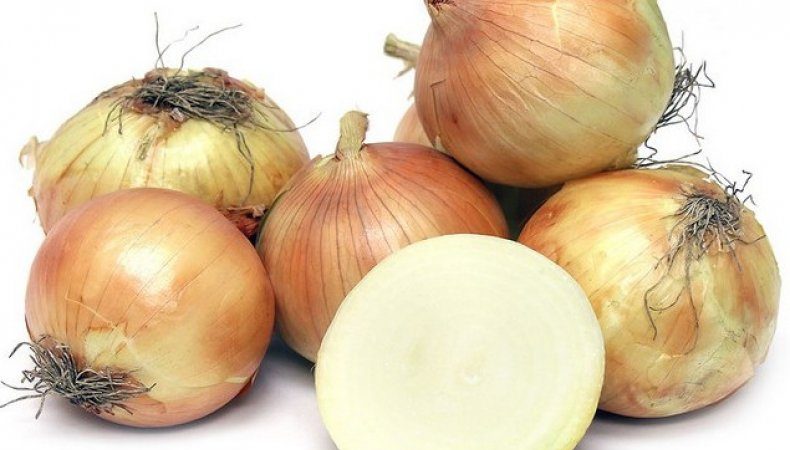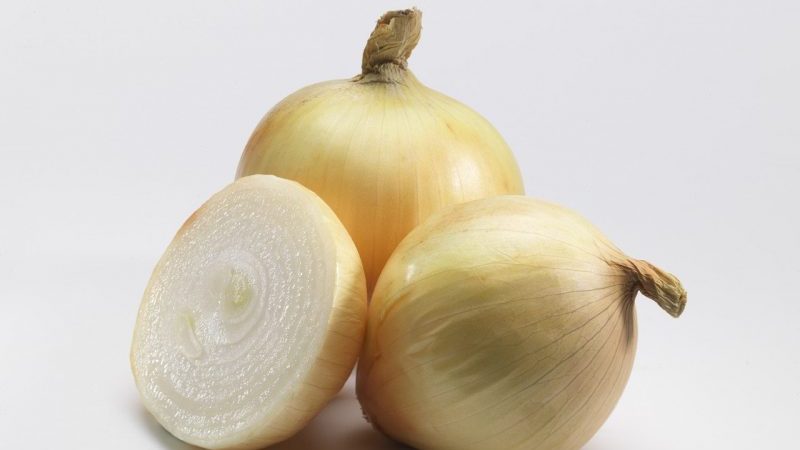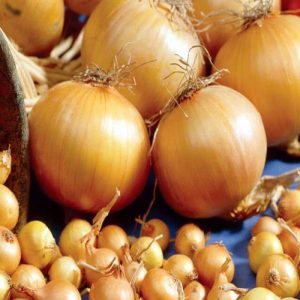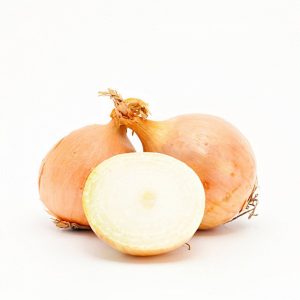High-yielding onion hybrid for long-term storage "Corrado"
The Dutch Corrado onion hybrid is resistant to many diseases and adverse climatic conditions. Due to its high yield, long storage, attractive presentation of vegetables and semi-sharp taste, the crop is suitable for commercial cultivation.
The content of the article
Description, origin and development
Corrado is a mid-season hybrid, recommended for growing on a turnip in a biennial culture from seedlings.
The Corrado onion was bred by Dutch breeders. Originator - NICKERSON ZWAAN B.V.
The hybrid was entered into the State Register of Breeding Achievements of Russia in 2015.

Composition and useful properties
Onions have bactericidal and antiseptic properties, they successfully fight viruses. Improves the absorption of food, increases the body's resistance to infections.
Chemical composition per 100 g:
- vitamin C - 10 mg;
- vitamin E - 0.2 mg;
- vitamin PP - 0.2 mg;
- vitamin B6 - 0.1 mg;
- vitamin B5 - 0.1 mg;
- calcium - 31 mg;
- magnesium - 14 mg;
- potassium - 175 mg;
- phosphorus - 58 mg;
- sulfur - 65 mg;
- iron - 0.8 mg;
- zinc - 0.85 mg.
Nutritional value per 100 g:
- calorie content - 41 kcal;
- proteins - 1.7 g;
- fats - 0.2 g;
- carbohydrates - 8.2 g;
- water - 86 g;
- dietary fiber - 2.5 g
The vegetable contains malic and citric acids, essential oils and sugars. All this makes it useful when consumed both fresh and when added to various dishes.
Ripening period and yield
In a southern climate, onions ripen within 95–98 days from the moment of emergence. In the middle lane the harvest is obtained in 100-105 days.
The marketable yield of the hybrid is 230–332 kg / ha. The maximum yield (609 c / ha) was recorded in the Moscow region. 3–8 kg of onions are harvested from 1 m² of plantings.
Disease resistance
Corrado is immune:
- to powdery mildew;
- gray rot;
- rust;
- yellow dwarfism;
- mosaic.
Subject to agrotechnical standards, pests and diseases are not terrible for the plant.
Specifications

Bow features:
- feathers are large green with a waxy coating;
- bulbs are rounded, approximately the same size with two buds;
- the neck is thin or medium;
- dry scales are golden brown, there are no more than 3 of them;
- juicy white pulp;
- delicate semi-sharp taste.
The mass of one onion is 90–110 g. There are specimens up to 190 g.
For which regions is it suitable
The hybrid is recommended for growing in the Central Black Earth, North Caucasian, Nizhnevolzhsky, West Siberian, East Siberian and Far Eastern regions.
Advantages and disadvantages
Positive characteristics of Corrado:
- long shelf life: if all conditions are met, the bulbs lie until spring;
- high percentage of ripening - 96% after ripening;
- lack of shooting;
- immunity to diseases and pests;
- high productivity;
- large, even bulbs.
Disadvantages: low frost resistance and high cost of seeding.
Planting and growing
For the cultivation of Corrado, they buy planting material, properly prepare the site, observe the sowing time and take care of the plants.
Preparing for landing
When choosing a place, it is important to observe the crop rotation. Onions are planted where legumes, cabbage, potatoes, rapeseed, beets, tomatoes, and mustard grew before.
Bad predecessors:
- garlic;
- oats;
- cucumbers;
- carrot;
- onion.
In the same place, the culture is grown only 2 years in a row. The next landing is recommended in 5 years.
Important! Only healthy bulbs are selected without damage, sprouted feathers and roots.
Sevok is not soaked by planting sevok: it is processed by the manufacturer.
Ground requirements
The Corrado hybrid grows well on fertile, loose and light soils. Sandy loams and loams with a neutral acidity level are suitable. If the soil is acidified, lime is added to the site 2 years before planting the onions.
The garden bed is prepared in the fall: it is dug up with compost, rotted manure or wood ash. If a mineral fertilizer is used (superphosphate or potassium sulfate), then no ash is added.
Timing, scheme and landing rules
Corrado is planted before winter, but the specific dates depend on the region. It is important that the air temperature does not drop below + 5 ° C and about 3 weeks remain before frost.
Sevok is planted according to the scheme: 5–10 cm between heads and 15–20 cm between rows.
The bulbs are buried about 5 cm above the neck, so as not to freeze them. The plantings are sprinkled with earth, the beds are mulched with dry grass or leaves. In winter, more snow is thrown onto the site, which saves the onion from low temperatures.
Attention! Planting sevka in autumn will allow you to get an earlier harvest.
In the spring, before planting, the sets are warmed up, for example, on a battery. For the development of culture, the air temperature must be at least + 12 ° C. This usually happens in late April or early May.
The onion is planted in the same way as in the fall, deepening it 2-3 cm above the neck.
Growing features

For a hybrid, a site is chosen at a certain elevation. So the sun's rays will fall on the plants, excess moisture will not accumulate, and strong wind will not damage plantings.
The favorable temperature for the cultivation of Corrado is + 18… + 20 ° C.
The nuances of care
Caring for a plant involves compliance with the main agrotechnical measures: watering, loosening, weeding, feeding, combating diseases and pests.
Watering mode
Moisturize planting 1-2 times every 7 days. In warm, dry climates, water is plentiful and frequent. In the middle of the growing season, the frequency of irrigation is halved.
Water the onion early in the morning or evening. Water at room temperature is poured carefully, not getting on the turnips themselves.
Attention! Irrigation is stopped 2-3 weeks before harvesting.
Loosening and weeding
After each watering or rain, the soil is loosened, weeds are removed. This will provide better nutrition for the roots, improve moisture and air permeability of the soil.
Timely weeding will prevent the development of diseases and attacks of harmful insects. Weeds take nutrients from the soil, slowing down onion development.
Important! Mulching will help curb weed growth and retain moisture longer.
Weed the beds with our hands so as not to damage the vegetables with a hoe.
Top dressing
Since Corrado bulbs are prone to the accumulation of harmful substances, it is better not to fertilize them with mineral compounds. With an obvious lag in growth, organic is used:
- mullein aqueous solution in a ratio of 1:10;
- bird droppings with water in a ratio of 1:15;
- wood ash - 30 g per 10 liters of water.
Top dressing is applied only to moistened soil so as not to burn the roots.
Onions are fertilized no more than 2-3 times during the growing season: when plants reach a height of 2-3 cm and 3-4 weeks after.
Disease and pest control
With proper cultivation techniques, the hybrid is resistant to major diseases and insects. Sometimes it is affected by the onion fly. Tobacco dust is sprayed against it over the garden bed, marigolds or calendula are planted.
If there are signs of disease, the plantings are treated with fungicides, the level of humidity, the amount of fertilizer applied, are monitored, the onions are weeded on time.
Harvesting and storage
The exact ripening time of onions depends on the weather and climate.
How and when to collect
For winter planting, the harvest is obtained in late July - early August. With spring sowing, the dates are shifted by a month.
The maturity of the bulbs is determined by yellowed tops. Collected in dry, sunny weather.
Onions for ripening are left in the garden for 2-3 weeks, then carefully removed from the ground, shaking off excess soil. Transferred to a dry room for drying. Feathers and roots are cut off from turnips, bad and damaged specimens are removed.
Storage features and keeping quality of the hybrid
For long-term storage, vegetables are placed in a cool place. A cellar or basement works well. The temperature is maintained there within the range of 0 ... + 3 ° C, humidity - 85%. At home, the indicators are different: temperature - + 18 ... + 22 ° C, humidity - 70%.
Vegetables are laid out in a cardboard or wooden box, a wicker basket, or hung from the ceiling.
Subject to all conditions, onions do not deteriorate until spring.
Growing difficulties
The main problems that vegetable growers face:
- The yellowing of feathers is caused by a lack of nutrients or improper plant care. To solve the problem of planting, they feed, water, weed on time.
- Fading of feathers occurs with a lack of nitrogen. For prevention, the culture is treated with a urea solution: 15 g per 5 liters of water.
- Curling feathers is a signal of a lack of potassium. Potassium salt is added to the beds: 7 g per 5 liters of water.
- The bitterness of onions is associated with hot weather. Solve the problem with more frequent watering.
Tips from experienced gardeners
For Corrado, top dressing is well suited, consisting only of natural substances. Some summer residents use a yeast remedy: 250 g of bread are poured into 5 liters of warm water, 250 g of green grass and 250 g of yeast are added. The liquid is infused for 2 days, used as fertilizer.
For onions, drip irrigation is used: this way the plantings are moistened evenly, they are not damaged by a strong jet of water.
Reviews
Gardeners love the taste and attractive presentation of the bulbs. The hybrid is easy to care for, the harvest is stored for a long time.
Yaroslav, Oryol: “The Corrado hybrid attracted by the fact that it was planted before winter. I didn’t take great care of the crop when growing it, but I got a big harvest ”.
Daria, Kostroma: “Last year I studied the description of hybrids, varieties, reviews about them - the Corrado onion caught my attention. I planted him, I was pleased with the result. The bulbs are even and firm, not too hot to taste. I fed vegetables with chicken droppings. "
Kirill, Uralsk: “I liked Corrado. His harvest is large, easy to grow, keeping quality is high. However, feathers sometimes begin to dry out. I solve the problem with additional watering and feeding. "
Conclusion
The Corrado hybrid is high-yielding, unpretentious in care, is not affected by diseases and pests, and almost fully ripens after ripening. Semi-sharp, even bulbs are stored until spring and are versatile in cooking.